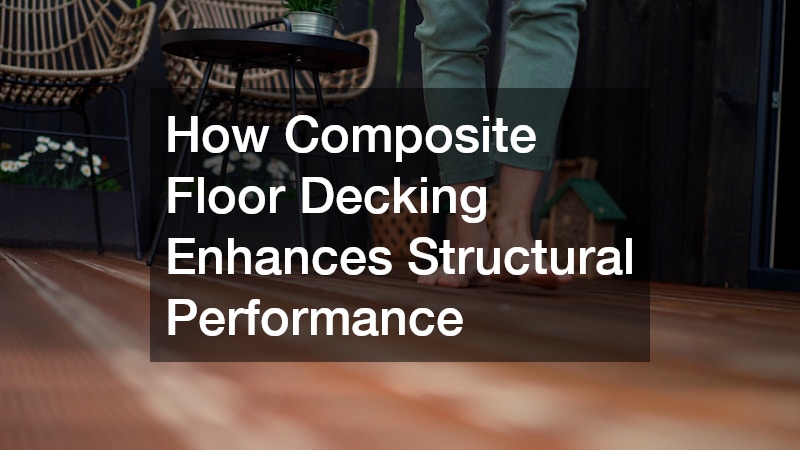Composite floor decking plays a vital role in modern construction, offering numerous advantages over traditional building materials. From commercial high-rises to residential renovations, its innovative composition delivers enhanced performance, durability, and design flexibility. As the construction industry evolves to meet higher standards in safety, sustainability, and cost efficiency, composite materials are increasingly being adopted for their ability to meet these demands.
This article explores the various ways composite floor decking enhances structural performance, including improved strength, environmental resistance, and architectural versatility. It also addresses common considerations such as cost-effectiveness and practical applications, helping architects, engineers, and property owners make more informed decisions in both new construction and retrofit projects.
What are the Benefits of Using Composite Floor Decking?
Increased Structural Strength and Stability
Composite floor decking materials are engineered to improve the overall strength of the structure. They are made by combining different materials, often a blend of metals, plastics, or natural fibers, to achieve superior tensile strength and stability.
One key advantage is that composite decking can distribute loads more evenly across the structure, further enhancing stability. This distribution helps in mitigating localized stress points that can lead to structural damage over time.
A study has shown that composite materials provide better performance in high-load scenarios compared to traditional wooden or metal decking. This makes them ideal for use in environments subjected to heavy traffic or dynamic loading conditions.
Resistance to Environmental Factors
Composite decking is less susceptible to degradation from environmental factors such as moisture and temperature changes. This resistance arises from the synthetic composition, which does not absorb water like natural wood, preventing swelling or rotting.
Additionally, composite materials are generally treated with ultraviolet (UV) inhibitors, reducing the risk of fading or weakened structural integrity due to prolonged sun exposure. These elements help maintain the decking’s appearance and functionality over time.
Moreover, composite decking’s resistance to insects and mold translates into fewer repairs and a longer lifespan. As climate patterns become more unpredictable, having a resilient decking material can significantly impact the longevity and safety of a building.
How Does Composite Floor Decking Impact Building Design?
Flexibility in Architectural Design
Composite materials allow for greater flexibility in design, accommodating unique architectural styles. The manufacturing process enables customization in terms of size, color, and finish, which can be tailored to meet specific aesthetic or structural requirements.
This flexibility allows architects to pursue creative designs without compromising on structural performance. Modern buildings often seek a balance between innovative aesthetics and reliable construction, a demand that composite decking effectively meets.
Furthermore, due to their adaptability, composite decks can seamlessly integrate with existing materials in renovation projects. This attribute makes them a preferred choice in both new builds and historical restorations seeking modern updates.
Lightweight Construction Options
The lightweight nature of composite floor decking contributes to reduced load on the building’s foundation. Compared to traditional materials like concrete, composites can lower the overall weight of a structure by a significant margin.
This weight reduction can decrease the seismic force impact on tall buildings, enhancing safety in earthquake-prone areas. It can also allow for smaller foundation systems, reducing construction time and costs.
In renovations, the lightweight attributes of composite decking simplify the process of retrofitting older buildings with modern infrastructure. It minimizes the need for extensive structural modifications, thus preserving the integrity of historically significant architecture.
Is Composite Floor Decking Cost-Effective?
Long-Term Durability and Lower Maintenance Costs
Due to its durability, composite floor decking typically incurs lower maintenance costs over time compared to traditional materials. Regular sealing, painting, or sanding, often required for wood decks, is unnecessary for composites.
This reduced maintenance results in substantial savings over the lifespan of the decking. Homeowners and businesses appreciate the predictable cost of upkeep, allowing more reliable budget allocations for building management.
In addition, the long lifespan of composite decking negates the need for frequent replacements, alleviating waste disposal concerns and environmental impacts. As green building practices gain popularity, investing in durable materials aligns with sustainable development goals.
Initial Cost vs. Long-Term Savings
While the initial cost may be higher, the long-term savings in repair and replacement can make composite decking a cost-effective choice. Many organizations see the upfront expense as a worthwhile investment due to the reduced lifecycle costs offered by composite materials.
Analyzing cost effectiveness requires looking beyond purchase price to total cost of ownership, a metric where composite decking often outshines traditional choices. Financially, the predictability in maintenance and longevity supports better long-term planning.
Additionally, composite decking is increasingly recognized by sustainable building certification systems, potentially qualifying projects for tax incentives or rebates. This financial benefit can further offset the initial expenditure, making composites a savvy choice for forward-thinking builders.
